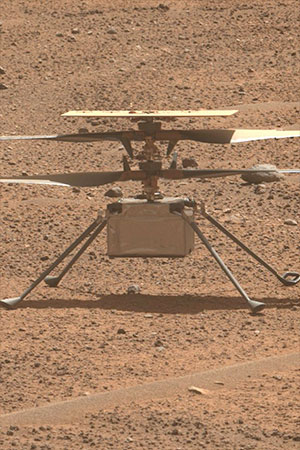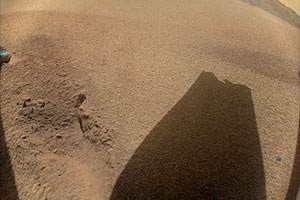January 26, 2024 — The first vehicle to achieve powered flight on another world has flown its last flight.
"Ingenuity," NASA's first helicopter to soar over Mars, suffered damaged to one or more of its rotor blades while completing its 72nd flight. While the small craft is still upright on the Martian surface and in communication with its flight controllers back on Earth, Ingenuity is no longer capable of lifting off into the thin Martian air.
"It is bittersweet that I must announce that Ingenuity, the little helicopter that could — and it kept saying, 'I think I can, I think I can' — well, it is now taken its last flight," said NASA Administrator Bill Nelson in a statement on Thursday (Jan. 25). "What started as a technology demonstration with plans for only up to five flights has now completed a remarkable 72 flights on Mars."
Launched from Earth with NASA's Perseverance rover, Ingenuity landed in Mars' Jezero Crater on Feb. 18, 2021. Two months later, at 3:34 a.m. EDT (0733 GMT or 12:33 p.m. Local Mean Solar Time on Mars) on Monday (April 19), the 1.6-foot-tall (0.49-meter) aircraft spun up its four carbon rotor blades and climbed to 10 feet (3 meters) where it hovered for 30 seconds.
It then descended and touched down on its four legs after 39.1 seconds in flight.
One thousand Martian days (sols) and 71 more flights later, Ingenuity has flown more than 14 times farther than planned and logged more than two hours of total flight time.
"The Wright brothers come to mind when we think about Ingenuity," said Teddy Tzanetos, Ingenuity's project manager at NASA's Jet Propulsion Laboratory (JPL) in Pasadena, California. "They unlocked the skies on Earth, made it commonplace to fly as part of our everyday lives. We all truly believe that Ingenuity has done the same for Mars and it's now unlocked the aerial exploration dimension."
"We couldn't be prouder of our little trailblazer," said Tzanetos.
Ingenuity's troubles began on what became its penultimate flight. On Jan. 6, the rotorcraft took off on what was expected to be a 125 second flight over 1,175.5 feet (358 meters). Instead, it traveled only 233 feet (71 meters) and touched down after just 35 seconds.
"We had an emergency landing due to the terrain where Ingenuity was flying," said Tzanetos. "She was flying around the surface and was realizing that there weren't too many rocks to look at or features to navigate from and that's why she called an emergency landing on her own."
"We believe the same thing happened on flight 72," he said.
On Jan. 18, Ingenuity's flight controllers planned a quick pop-up vertical flight to check out the helicopter's systems as a result what happened two weeks earlier. Data that Ingenuity sent to Perseverance (to be relayed to Earth) indicates it had reached its maximum altitude of 40 feet (12 meters), but communications between the helicopter and rover cut off early, prior to Ingenuity's expected touchdown.
"All of our engineering judgment leads us to believe that during the descent we had a blade strike with the surface of Mars," said Tzanetos. "We downlinked a set of images. The team looking at those images confirmed the shadow of one of our rotor blades, which suggests that rotor blade is damaged."
The team is still in the process of collecting more imagery in hopes of learning the status of the other blades. They also anticipate Perseverance, which is busy on its science mission, may be able to take photos of Ingenuity from about 650 feet (200 meters) away, but they are not expected to be very good given the distance.
Despite its sudden demise, Mars' first helicopter has earned its place in the history books and is already reshaping NASA's approach to planetary exploration going forward.
"It was the first aircraft to execute a powered, controlled flight on another world; the first to take off and land under control; and first aerial scout on another planet," said Laurie Leshin, JPL director. "It has been recognized appropriately with numerous awards, including the Collier Trophy and Michael Collins Trophy from the [National] Air and Space Museum and the National Space Club's Robert Goddard Memorial Trophy."
"I look forward to the day that one of our astronauts brings home Ingenuity and we can all visit it in the Smithsonian," said Leshin. "In the meantime, you can visit one of our pre-flight models there." |
|

Ingenuity, as imaged by the Perseverance rover on Aug. 2, 2023, a day before the helicopter's 54th flight. (NASA/JPL/ASU/MSSS)

Ingenuity captured this image after its 72nd and final flight on Jan. 18, 2024. It shows the shadow of a rotor blade that was damaged during a rough landing. (NASA/JPL)

Ingenuity captured this view of sand ripples during its 70th flight on Dec. 22, 2023. The smooth, relatively featureless terrain proved difficult for the helicopter's navigation system to track. (NASA/JPL) |
